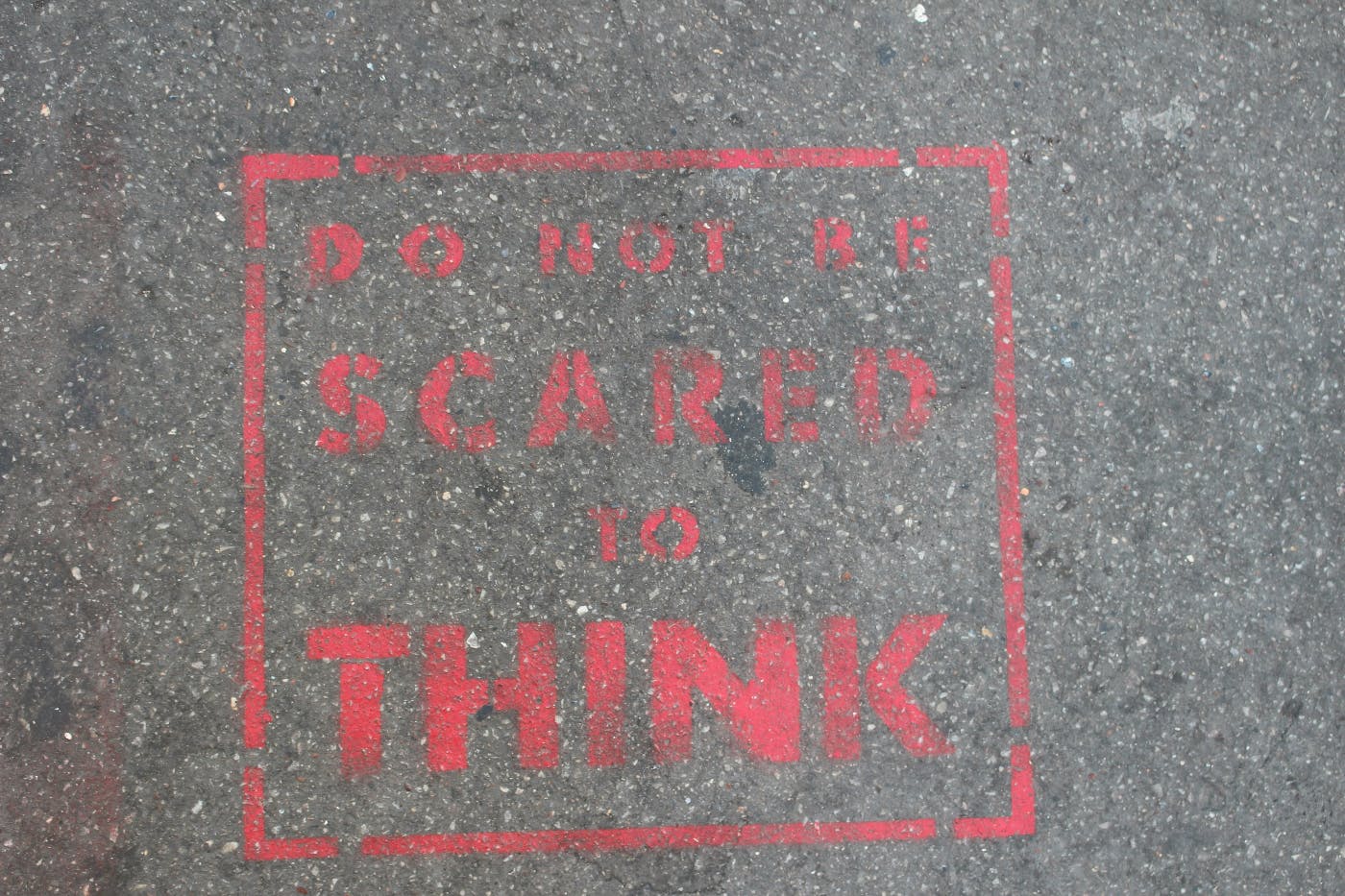
What if we didn’t just tweak our current methods but instead dismantled them entirely, asking ourselves fundamental questions about how marketing and branding actually work?
Okay, stay with me on this one. It’s going to be a bit byzantine at the start, but I believe it will make sense when I get to the end. Maybe not, as, frankly, I am putting this together even as I write.
I spend my days thinking about marketing and branding, as that is what Thoughtlab does and does well. I am a cog in the ThoughtLab wheel, tasked with writing blogs about stuff that will get eyes to tell fingers and minds to come to ThoughtLab for all your marketing and branding needs. To do this, I keep my eyes and ears open to things that might interest and spark curiosity and make the reader say, you know, my business is lacking; I want to see what this ThoughtLab place has to offer.
I write about storytelling, niche marketing, social media, and all things directly related to marketing and branding—connections that are obvious and require little thought to make. The other day, I came across an article about Alexander Grothendieck. This connection will be a little more challenging to make, but one that I believe is worth it.
For those of you who don’t know, and don’t feel bad if you don’t, I had no idea who this dude was until I saw the article. Grothendieck was a mathematician who didn’t just solve problems—he reinvented how we approach them. Rather than refining old ideas, Grothendieck dismantled established concepts and built entirely new frameworks. His work in algebraic geometry, particularly the development of schemes, redefined how mathematicians understood the connection between algebra and geometry. By focusing on the relationships between objects rather than the objects themselves, he created more adaptable and powerful systems. His legacy isn’t just about technical breakthroughs—it’s about rethinking from the ground up.
I know squat about math. Seriously, I once had a teacher threaten to cut off my fingers in school because I had to count on them to do math. Apart from being terrifying, it made me run from math. So, you don’t have to be a math genius to follow this. I want to focus on rethinking things from the ground up, mainly marketing and branding. Taking inspiration from Grothendieck., pronounced grow-tuhn-deek, I want to ask questions and examine the possibility of rethinking how we market and brand.
It's heady stuff for a Friday, and I’m not promising any answers. However, I am hoping to spark conversations. Okay, breathe, and read on.
A Bit on Schemes
Grothendieck's concept of schemes revolutionized algebraic geometry by providing a more flexible and general framework for understanding geometric objects. Traditionally, mathematicians used algebraic varieties to describe solutions to equations, but these had limitations in handling complex cases. Grothendieck's schemes expanded this idea, allowing mathematicians to study not just points and shapes but also the relationships and structures that connect them. This shift gave a deeper, more adaptable way to explore the connections between algebra and geometry, opening up new possibilities across various fields of mathematics.

Let’s Rethink
Marketing and branding have followed relatively consistent patterns for decades. We focus on identifying target audiences, crafting messages that resonate, and delivering those messages through increasingly sophisticated channels. Every few years, trends like social media, influencer marketing, or content marketing shift the landscape, but the foundational concepts remain largely the same. We assume we need a brand, a target audience, a value proposition, and a message.
But what if we approached marketing like Alexander Grothendieck approached mathematics? What if we didn’t just tweak our current methods but instead dismantled them entirely, asking ourselves fundamental questions about how marketing and branding actually work? What if we reimagined the entire system?
What if?
Questioning the Basics
The first step Grothendieck might take if he were in our shoes would be to question the basic assumptions that underpin marketing today. We often take certain things for granted, like the idea that marketing is about getting the right message to the right audience. But Grothendieck didn’t just accept established norms—he asked why they were there in the first place. For us, that might mean asking questions like:
- Why do we assume that brands need a consistent message across all platforms?
- What if a brand’s identity were fluid, adapting in real-time to the needs of its audience?
- Why do we categorize audiences into fixed segments like demographics or psychographics?
- Could there be more meaningful ways to define an audience, like by emotional states or evolving needs?
In marketing, we typically create customer personas or audience segments based on relatively static attributes—age, gender, income, and interests. These segments become the foundation for targeted messaging, but what if these segments aren’t the most meaningful way to connect with consumers? What if authentic connections are more dynamic, complex, and relational, much like Grothendieck’s schemes sought to reframe geometry?
Shifting from Objects to Relationships
Grothendieck’s innovation in mathematics was in shifting focus from the objects themselves (like points, lines, and shapes) to the relationships between these objects. In branding, we often focus on the brand as an object, something with fixed characteristics: a logo, a slogan, or a mission statement. But if we follow Grothendieck’s lead, perhaps we should focus on the relationships a brand fosters with its audience instead.
Instead of asking, “What is my brand?” we could ask, “How does my brand relate to the individuals who interact with it?” This shift in focus opens up new possibilities. For example:
- What if brands didn’t have static identities but were constantly evolving based on real-time data from customer interactions?
- Could a brand exist as a series of personalized experiences rather than a singular, monolithic entity?
- Could marketing be less about pushing a message and more about facilitating a dialogue between a brand and its audience?
This relational thinking moves us away from rigid, one-size-fits-all strategies and toward something more organic and adaptive. Just as Grothendieck's schemes allowed for greater flexibility in mathematics, a relational approach to branding could lead to more fluid, responsive marketing strategies.
Breaking Down the Idea of “Audience”
Another area ripe for rethinking is the concept of audience. Traditional marketing assumes that audiences can be neatly divided into segments—mothers, millennials, business executives, etc. However, this segmentation often flattens the complexity of human behavior. In his work, Grothendieck didn’t accept the classical division of geometric spaces; he saw a need for new structures to describe more complex realities.
In marketing, perhaps we should similarly move away from rigid segmentation. Rather than grouping people by surface-level characteristics, what if we dug deeper into understanding their underlying motivations and states of being? For example, instead of targeting someone based on their job title, could we market to them based on their current mindset, emotional state, or even the time of day?
This kind of dynamic segmentation could be more effective because it taps into real-time data and adapts based on a person's needs in the moment. Imagine an AI-driven marketing campaign that shifts tone, content, and delivery method based on the recipient’s emotional state as they interact with your brand. Instead of sending the same message to all "millennial moms," we could target individuals based on factors like their mood, immediate needs, or even external conditions like weather or location.

Marketing as an Ecosystem
Grothendieck didn’t just change how people solved problems; he changed how they thought about problems in the first place. In marketing, we often treat campaigns as isolated events: a product launch, a seasonal sale, or a social media blitz. These campaigns are designed, deployed, and then evaluated based on their results. But what if we didn’t think of marketing in these terms?
Instead of thinking about individual campaigns or messages, what if we viewed marketing as an ecosystem—a constantly evolving network of interactions between a brand and its audience? In such an ecosystem, marketing wouldn’t be about delivering isolated messages but about creating environments where engagement naturally occurs. Brands wouldn’t "push" messages; they would cultivate spaces where consumers come to them, drawn by the value and experience the brand creates.
This requires a fundamental shift in how we think about branding. Brands would need to become less about "saying" things and more about doing things that matter to their audience. What if your brand didn’t need an ad campaign to announce its next product? What if your brand had already created a space where consumers were so engaged that they eagerly anticipated what came next?
The Power of Abstract Thinking in Marketing
One of the reasons Grothendieck was so successful is because he wasn’t afraid to embrace abstraction. He dealt with highly abstract concepts, often far removed from the immediate realities of classical mathematics. In marketing, we sometimes avoid abstraction because it feels disconnected from the concrete results we need to deliver—leads, conversions, and sales.
But embracing abstraction can also lead to breakthrough ideas. By thinking about marketing as an abstract system of relationships and interactions rather than a series of tactical maneuvers, we might unlock new ways to connect with audiences in more meaningful, lasting ways.
Take, for example, the concept of brand loyalty. Traditionally, we measure loyalty through metrics like repeat purchases or engagement rates. But loyalty, in its truest sense, is a relationship built on trust and mutual benefit. What if we redefined loyalty not as a metric but as an evolving, dynamic relationship between a brand and its audience? How might that change the way we approach customer retention, product development, and even brand messaging?
It Is Different, Isn’t It
Traditional marketing and branding focus on static elements: clear brand identities, fixed target audience segments, and predefined messaging. We categorize consumers based on demographics or psychographics and deliver carefully crafted messages to fit those groups. The goal is often to create consistency across all platforms and touchpoints, ensuring the brand maintains a recognizable identity that appeals to its intended audience. This approach works but is rigid and assumes that the brand and audience remain constant over time.
If we apply Grothendieck’s thinking, we will shift from this rigid model to something more fluid and adaptable. Instead of focusing on static brand identities and fixed audience segments, we’d focus on the relationships between brands and their audiences, which are dynamic and ever-changing. Marketing would become less about pushing a consistent message and more about fostering ongoing, evolving consumer interactions. Brands could shift their identities in real-time based on audience needs, moods, or behavior, creating more personalized, flexible experiences. This approach embraces complexity and adaptability, much like Grothendieck’s schemes did for geometry, allowing for deeper and more meaningful connections.

Summing Up: The Grothendieck Lens on Marketing and Branding
The beauty of Grothendieck’s work is that it wasn’t about finding a single solution but creating frameworks that allowed infinite possibilities. Applying this thinking to marketing and branding can help us break free from the limitations of our current approaches and imagine new, more fluid ways to connect with our audiences.
By questioning the foundational assumptions of marketing, shifting our focus from objects to relationships, and embracing a more dynamic, ecosystem-like approach, we can rethink how we build brands and engage with consumers. This doesn’t mean throwing out everything we know—rather, it means using Grothendieck’s lens to reimagine how we approach the work we do.
The marketing world is full of templates, formulas, and best practices. But as Grothendieck showed us, sometimes the most powerful breakthroughs come when we question everything and start anew.
ThoughtLab: Where Bold Questions Drive Bold Solutions
At ThoughtLab, we don’t just follow the traditional marketing and branding rules—we challenge them, constantly seeking fresh perspectives to deliver results that matter. Our approach is rooted in asking the tough, foundational questions others might overlook. We push beyond conventional strategies to discover new, untapped ways for your brand to connect with audiences in a dynamic and meaningful way. Like Grothendieck's revolutionary thinking, we believe real success comes from reimagining the basics. Whether creating adaptable brand experiences or pioneering innovative marketing tactics, ThoughtLab is where big ideas meet big results. Let’s rethink what’s possible—together.

